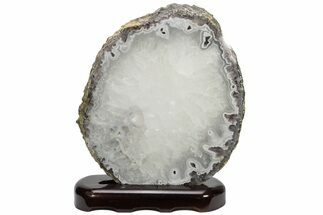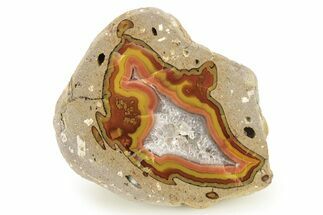This Specimen has been sold.
7" Polished Brazilian Agate Slice
This is a gorgeous polished Brazilian agate slice. It comes with an acrylic display stand.
Agate is a translucent variety of microcrystalline quartz. Agate primarily forms when silica-rich fluids fill pockets within rock and/or fossils, depositing it along the walls of the rock. This process can result in banding patterns as fluid compositions and impurities change over time. These banding patterns can either form as flat layers, forming agates known as waterline agates, or as concentric layers typical of most agates, depending on the surfaces available for deposition.
Agate has also been known to fill veins or cracks in volcanic rock. Such agates, when cut transversely, exhibit a succession of parallel lines giving a banded appearance to the section. Such stones are known as banded agate, riband agate and striped agate.
Agates from Brazil are mined from decomposed volcanic ash and basalt from the late Permian age (248-275 million years old). In Rio Grande do Sul, the agate "mines" are normally just plowed fields in which loose agates are found and collected. These agates can be very colorful and polish beautifully.
Agate has also been known to fill veins or cracks in volcanic rock. Such agates, when cut transversely, exhibit a succession of parallel lines giving a banded appearance to the section. Such stones are known as banded agate, riband agate and striped agate.
Agates from Brazil are mined from decomposed volcanic ash and basalt from the late Permian age (248-275 million years old). In Rio Grande do Sul, the agate "mines" are normally just plowed fields in which loose agates are found and collected. These agates can be very colorful and polish beautifully.
About Agate
Agate is a variety of microcrystalline quartz (chalcedony) that displays translucence and, in some cases, banding. Agate primarily forms when silica-rich fluids fill pockets within rocks and/or fossils, depositing the silica along the walls of the rock. This process can result in banding patterns, as the compositions and impurities of these depositing fluids change over time. These banding patterns can either form as flat layers, creating linear patterns known as waterline agate, or as rounded layers, forming more common ring-like patterns. These patterns depend on the surfaces available for deposition.
Agate is a variety of microcrystalline quartz (chalcedony) that displays translucence and, in some cases, banding. Agate primarily forms when silica-rich fluids fill pockets within rocks and/or fossils, depositing the silica along the walls of the rock. This process can result in banding patterns, as the compositions and impurities of these depositing fluids change over time. These banding patterns can either form as flat layers, creating linear patterns known as waterline agate, or as rounded layers, forming more common ring-like patterns. These patterns depend on the surfaces available for deposition.
About Quartz
Quartz is the name given to silicon dioxide (SiO2) and is the second most abundant mineral in the Earth's crust. Quartz crystals generally grow in silica-rich environments--usually igneous rocks or hydrothermal environments like geothermal waters--at temperatures between 100°C and 450°C, and usually under very high pressure. In either case, crystals will precipitate as temperatures cool, just as ice gradually forms when water freezes. Quartz veins are formed when open fissures are filled with hot water during the closing stages of mountain formation: these veins can be hundreds of millions of years old.
Quartz is the name given to silicon dioxide (SiO2) and is the second most abundant mineral in the Earth's crust. Quartz crystals generally grow in silica-rich environments--usually igneous rocks or hydrothermal environments like geothermal waters--at temperatures between 100°C and 450°C, and usually under very high pressure. In either case, crystals will precipitate as temperatures cool, just as ice gradually forms when water freezes. Quartz veins are formed when open fissures are filled with hot water during the closing stages of mountain formation: these veins can be hundreds of millions of years old.
SPECIES
Chalcedony var. Agate
LOCATION
Rio Grande do Sul, Brazil
SIZE
7" wide, .2" thick
CATEGORY
SUB CATEGORY
ITEM
#156302
 Reviews
Reviews













